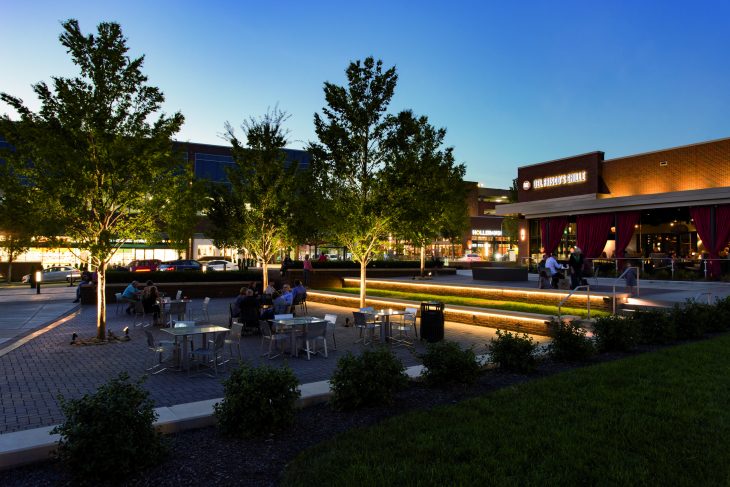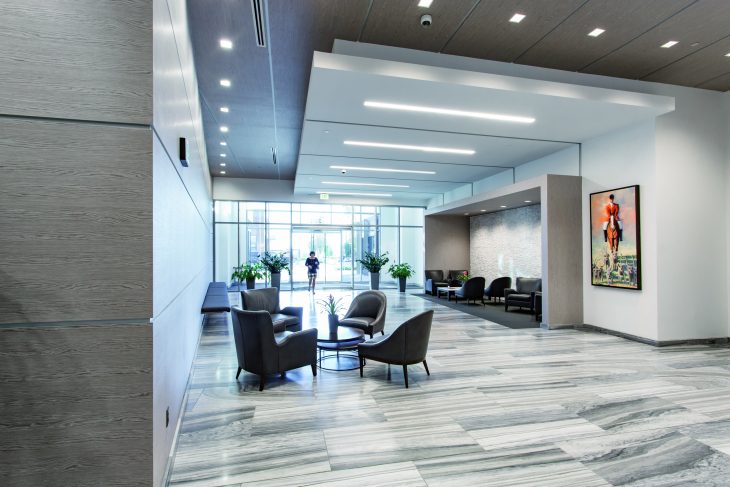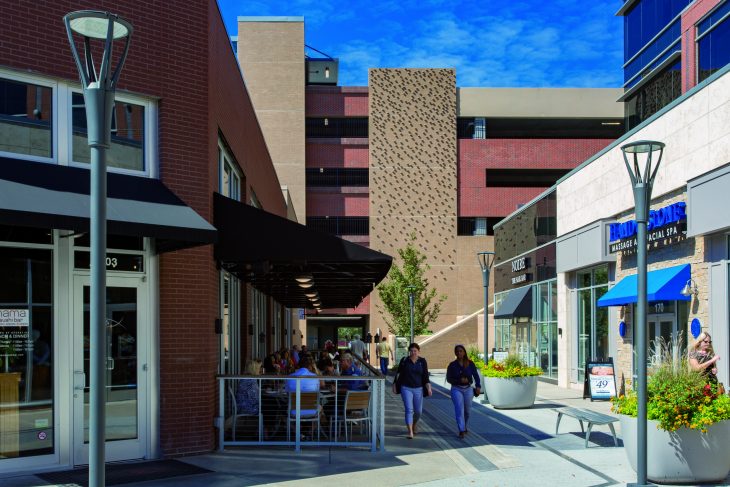Why a focus on fresh air design strategies and outdoor workspace will help rejuvenate employees and reinforce a positive workplace culture.

Nestled between historic buildings and modern office towers in the geographic center of Downtown Atlanta, Woodruff Park is a 6-acre green space and gathering place for a diverse cross-section of locals and visitors alike. The public area is also conveniently located within a few blocks of my desk inside COOPER CARRY’s Atlanta office, making Woodruff Park my go-to green space for a daytime diversion.
When I walk over around lunchtime, it’s commonplace today to see people working on laptops. However, using the park as an outdoor office is a relatively new phenomenon. Last fall, the greenspace joined a handful of other hotspots across metro Atlanta that have added free WiFi for guests within recent years.
While offering high-speed internet access may be the most important amenity for today’s workforce to get outside, it’s not the only element necessary. Here are three key design considerations to help employers and employees make the shift to functional outdoor workspaces where work, community and nature come together.
Room to Unplug
So, why should employers want to encourage employees to use outdoor workspace? A long list of recent studies have touted the various health benefits tied to biophilic design and spending time outside, from improving short-term memory, lowering blood pressure and protecting vision to boosting creativity, restoring focus and reducing stress. Simply put, taking a short break in the work day can go a long way in keeping employees healthy, happy and more productive when they return to their desks inside.
With these benefits in mind, consider adding defined areas for contemplation and solace. Whether someone is finding respite from a stressful day or mentally preparing for a big meeting, people desire spaces to unplug without having to go too far from work—after all, coworkers can still be just a phone call or email away via a smartphone. Options for enhancing the user experience could include installing a bench by a soothing water fountain or designing a nature trail with a labyrinth for walking meditation.
At Hill Center, a 32-acre, mixed-use community in the heart of Brentwood, Tennessee’s business and retail district, dedicated areas were designed for contemplation on the walk to and from the parking garage. When workers need to get out of the office, they can take in the tranquil surroundings of the adjacent Maryland Way Park trails or, depending on the time of day, perhaps find a peaceful moment at the central green space.

Fun and Functional Furniture
In terms of necessities for contemporary outdoor workspaces, a close second to WiFi are tables and chairs. While these may sound obvious, first consider the surrounding environment and whether the space is privately or publicly controlled. This distinction can help determine what types of furnishings the space needs.
In a public space operated by a municipality or a park association, flexible furniture is preferable as the space will probably be used for other purposes. In Woodruff Park, guests spread out among brightly colored bistro tables and chairs. While these might not be the most comfortable for prolonged periods of time, they are just fine for 30 minutes to an hour. If the intention is for people to work for a short amount of time or enjoy lunch, the seating doesn’t have to be plush.
If the space is privately owned, furniture can be heavier, comfortable and relaxing, such as Adirondacks chairs. At Hill Center, there are sturdy tables and chairs—permanent furniture that isn’t folded up and put away each night. Office tenants at Hill Center often take advantage of this community amenity, especially employers who use a hoteling model. Made popular by the rise of coworking where employees might not have assigned desks, this concept is becoming more mainstream for companies that permit flexible hours or work-from-home days for employees.
Although there might not be an expectation for workers to be in the office from 9-5 Monday through Friday, many employers are still seeking new ways to make coming into—and working at—an office more appealing and inspiring for their teams. If employees prefer to stay onsite, they are more available to attend an impromptu meeting or have an organic interaction with a colleague that sparks a bright idea. Creating an outdoor connection that resonates with workers can help facilitate these types of seemingly inconspicuous yet significant touchpoints that drive productivity and overall business growth.

One Size Doesn’t Fit All
Just as it’s important to have a peaceful place designed for one, successful outdoor workspaces also require social areas for people to congregate, meet and collaborate.
Consider offering different scales of spaces that serve one person to groups of 10 or more. Through thoughtful landscape architecture, a variety of outdoor rooms can be created with different heights of plants, trees and elements arranged in relation to each other. Programming can also play an important role in bringing groups of people together, from installing volleyball courts to adding a game of cornhole.
Taking cues from trends in hospitality and residential design, today’s office projects don’t just prioritize having their own public space, but also benefit when integrated in mixed-use town centers because these offer more social areas where people can come together or take a healthy break from the work day. Vibrant activity hubs also attract millennial talent, who consistently demonstrate a preference for working near walkable areas with access to retail and restaurants, public transit and the place they call “home.”
Overall, a successful outdoor workspace design is centered around who is using the space and how, and then offers simple solutions to fit their needs. These needs can also vary based on the company’s culture or industry demands.

Currently, project called Legacy Park in Decatur, Georgia – a suburb of Atlanta that serves as a home base to creatives, nonprofits and residents – is underway. The city is taking the lead in reimagining a 77-acre site into public green space, recreation, office space and multifamily housing. It was critical to find a connection to the outdoors and communal spaces that would inspire and engage users in a community not typically associated with traditional office space and make everyone feel welcome. Employees can not only enjoy lunch in the park, but could also contribute to the community by holding an afternoon lecture series or hosting a public art competition.
Likewise, another project is in the early planning phases for an art-centric client that seeks to blend the edge between work and the public realm. Here, there are similarities to how time is spent at home, on front porches or in backyards, where people want to be in the public realm but not completely exposed. For example, a coworking space located on a public courtyard could install roll-up doors that open to the outdoors when the weather is nice or during an office happy hour. By creating special moments and balancing the uses of people surrounding an office, design can create outdoor workspaces that feel inviting to all.
So many of us spend at least eight hours in our offices on most days. And, with constant access via our smartphones, we’re rarely ever unplugged. Breaking up the day with a change of scenery—whether it’s for a few hours or a few minutes– can press the reset button and recharge employees so when they’re back in the office, they’re performing at their personal best. By focusing on fresh air design strategies that rejuvenate employees and reinforce a positive workplace culture, companies will position themselves for future growth and success in the next decade.


